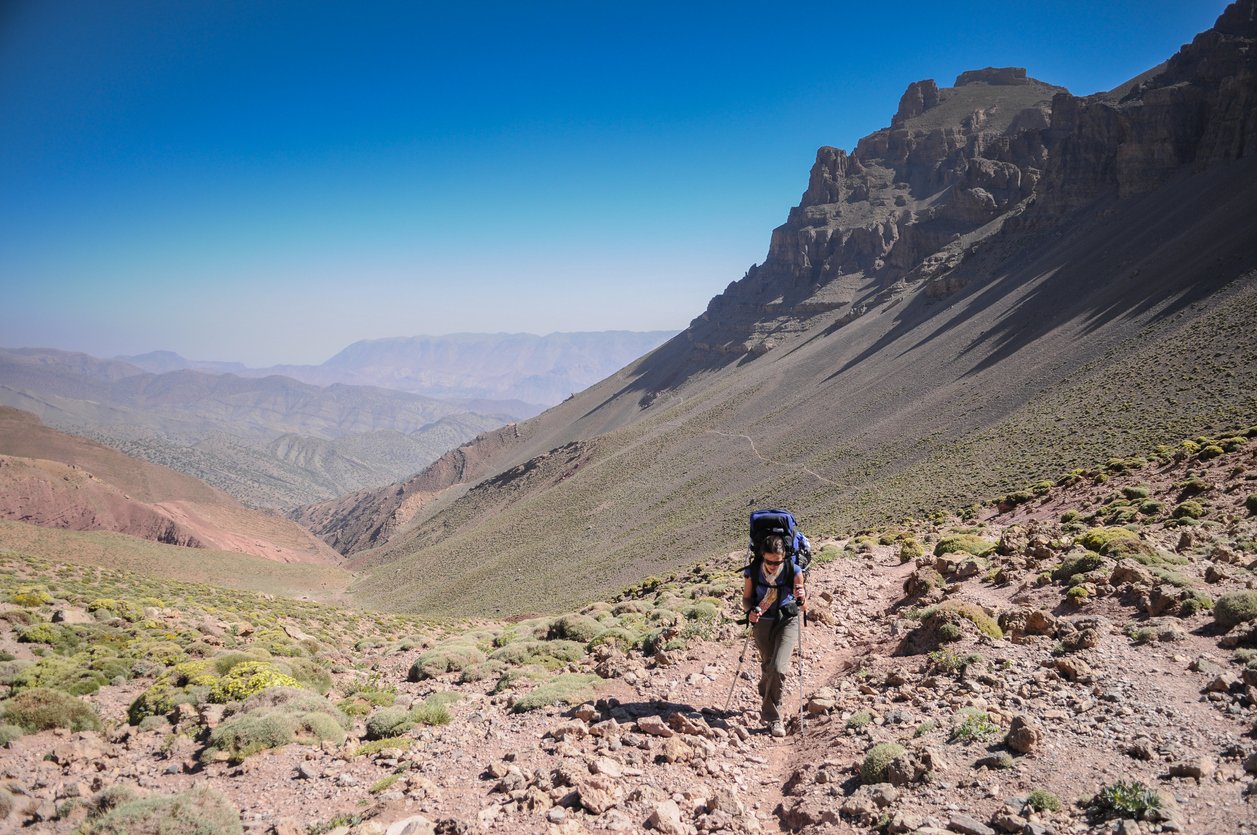
Hiking in Morocco can involve anything from vast, lunar-like deserts to dramatic snowcapped mountains, and a whole lot in between. And yet, it's safe to say that hiking is not what Morocco is best known for. If we were to play the word association game right now and say “Morocco”, you probably wouldn't say “trekking” would you? You’d be more likely to say something like “desert”, “sand”, "mint tea" or maybe “tagine” (yum) - but trekking in Morocco can be pretty epic.

Unlike some countries, Morocco doesn’t have any long distance footpaths or famous trekking trails running through it. But that doesn't mean you can't strike out on a multi-day hike across the pristine Atlas Mountains, or find a route from desert to ocean. What it means is that the hiking in Morocco is largely untapped - you won't find crowded trails here. To see what’s on offer, you’ll need to know where the mountains are.
Step aside cities, we want wilderness. Here is a rough map for your perusal, which outlines Morocco's four mountain ranges and the highest peak in each. Click on the map to find out more.
The four main mountain ranges in Morocco are:
- The High Atlas
- The Middle Atlas
- The Anti-Atlas
- The Rif Mountains
Then, just to spice things up, the edge of the Sahara desert creeps into Morocco - a vast desert of undulating red-gold dunes. If you’re curious about what it’s like trekking on sand, there’s your challenge.
What National Parks in Morocco Have Hiking Trails?
There are an astounding 11 national parks in Morocco, alongside numerous nature reserves, many of which offer up some exciting hikes. They've been set up to preserve Morocco's flora and fauna, including some endangered species, so you'll be trekking through some of the country's most biodiverse terrain. While some of the trails are clearly defined and signposted, for others you will need to map your route, or employ the services of a guide.
Toubkal National Park is a popular destination for trekkers. Although it's most well-known for Mount Toubkal, the highest in the country at 4,167m, it encompasses an area of 380 square kilometres of mountains, gorges, forests and plateaus. There are plenty of trails to hike in Morocco, including many up Mount Toubkal, but it's worth exploring the rest of the park too. A lot of trails begin in the picturesque village of Imlil - we recommend taking the trail to Imlil Cascades and then heading up Tizi Mzzik (2,500m), which offers up spectacular views of the surrounding mountains and valleys.
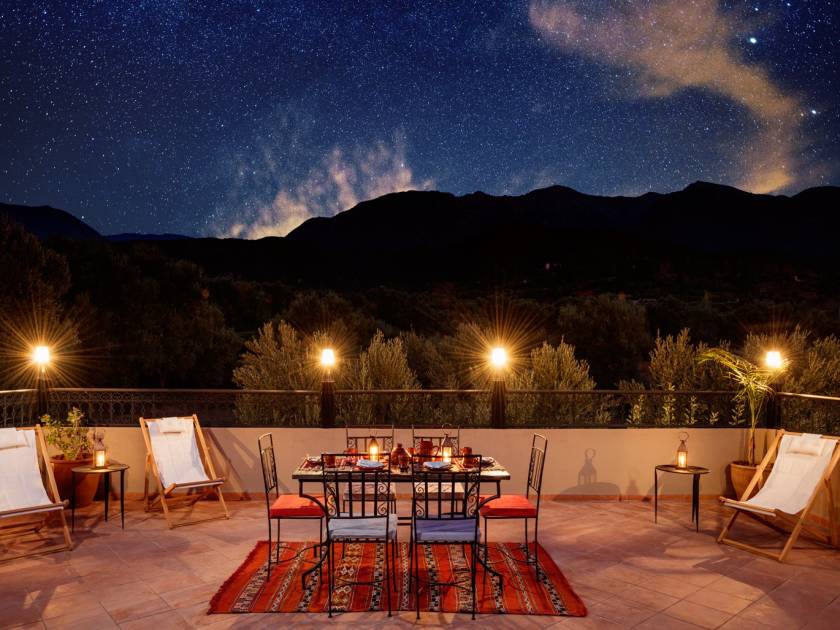
Ifrane National Park is situated in the Middle Atlas, at a lower elevation to Toubkal National Park. Alongside the soaring Atlas peaks, visitors can hike in the dense forests carpeting the foothills - they boast 1,000 species of vegetation, including the rare Atlas cedar, and are home to endangered Barbary macaque. One of the most popular trails is the Monkey Trail, also known as the 3M Squared Loop Trail, which takes you on an eight-kilometre loop through cedar and oak forest, providing some wonderful opportunities for wildlife watching.
The Souss Massa National Park is located on Morocco's southwest coast, and includes sandy beaches, wetands and estuaries renowned for their rich birdlife. There are two entry points to the park - via Rokein Information Centre, where you can hike along marked trails along the coast between ocean and grassland, or at Sidi Binzarne, where you can follow the five kilometre trail along Oued Massa estuary.
As you can tell already, the trekking in Morocco can be incredibly diverse. There are plenty of reasons to go to Morocco for hiking - but where specifically to go? Well, here are the main ranges.

A Trekking Guide to the Mountain Ranges of Morocco
1. The High Atlas Mountains
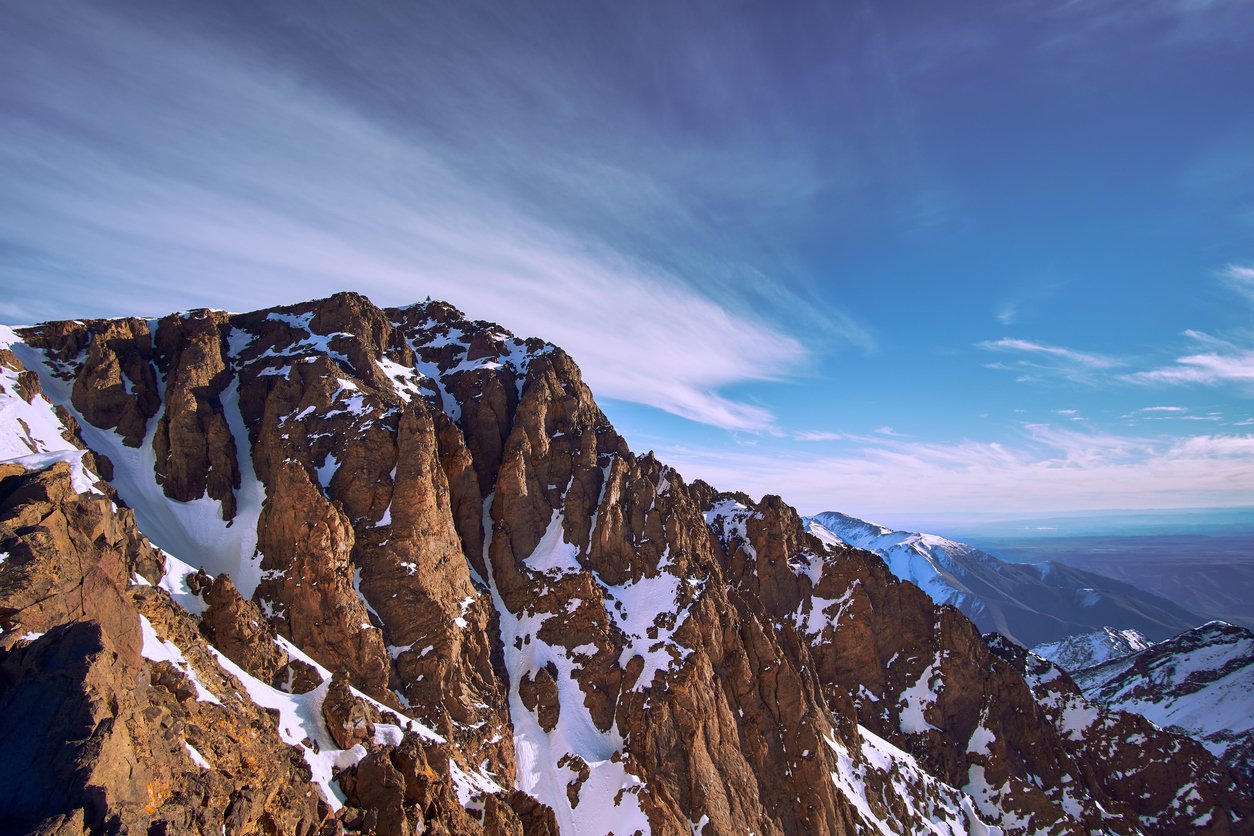
Highest Point: Mount Toubkal (4,167m)
Best Time to Visit: May-June, Sept-Oct
Best Multi-Day Adventure: Climb Mount Toubkal
All of the big peaks in Morocco can be found in the High Atlas mountains. Morocco has five mountains above 4000m: Toubkal, Ouanoukrim, M’Goun, Afella and Akioud. Those are in height order, with Toubkal at the highest and Akioud only just making it into the 4000-ers category. Even more excitingly, these top three peaks also happen to be the highest three mountains in the whole of North Africa.
Mt Toubkal is North Africa's highest peak. At 4167m tall, reaching the summit of Toubkal is no mean feat. In winter it is definitely mountaineering, with all the associated paraphernalia needed to reach the summit safely. In summer, the weather can get extremely hot. Your best chance of a snow-free-but-not-boiling trek is in September to October, or April to May. That’s when it’s cool enough to hike but not so cold you need crampons. Treks are possible in high summer, but expect it to be very hot.
Toubkal is a multi-day trek rather than a day trip. Around the foot of the mountain you'll pass the Kasbah du Toubkal. Then, climbing up, you should each the refuge up the mountain on day one, and then climb to the actual peak of Toubkal the next day. Another option is the Mount Toubkal Circular Route, which takes you through the verdant Azzadene Valley and over the Aguelzim Mountain pass before you attempt the Toubkal summit.
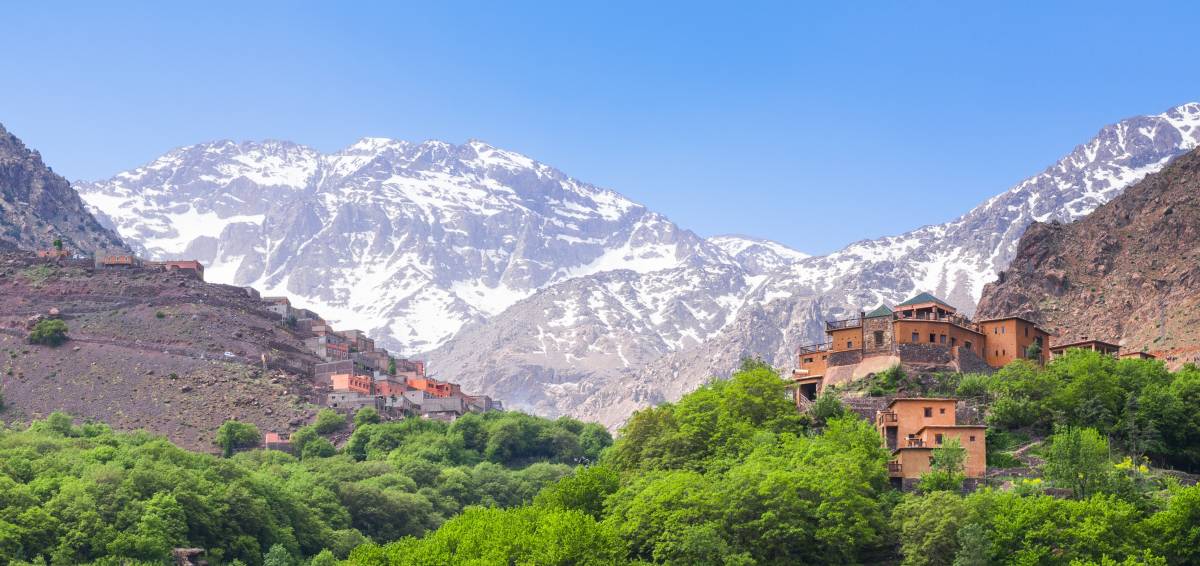
Good local guides will tell you the history of the region en route - of the Berber people and Berber villages, and of the first people to make it up Toubkal in 1923.
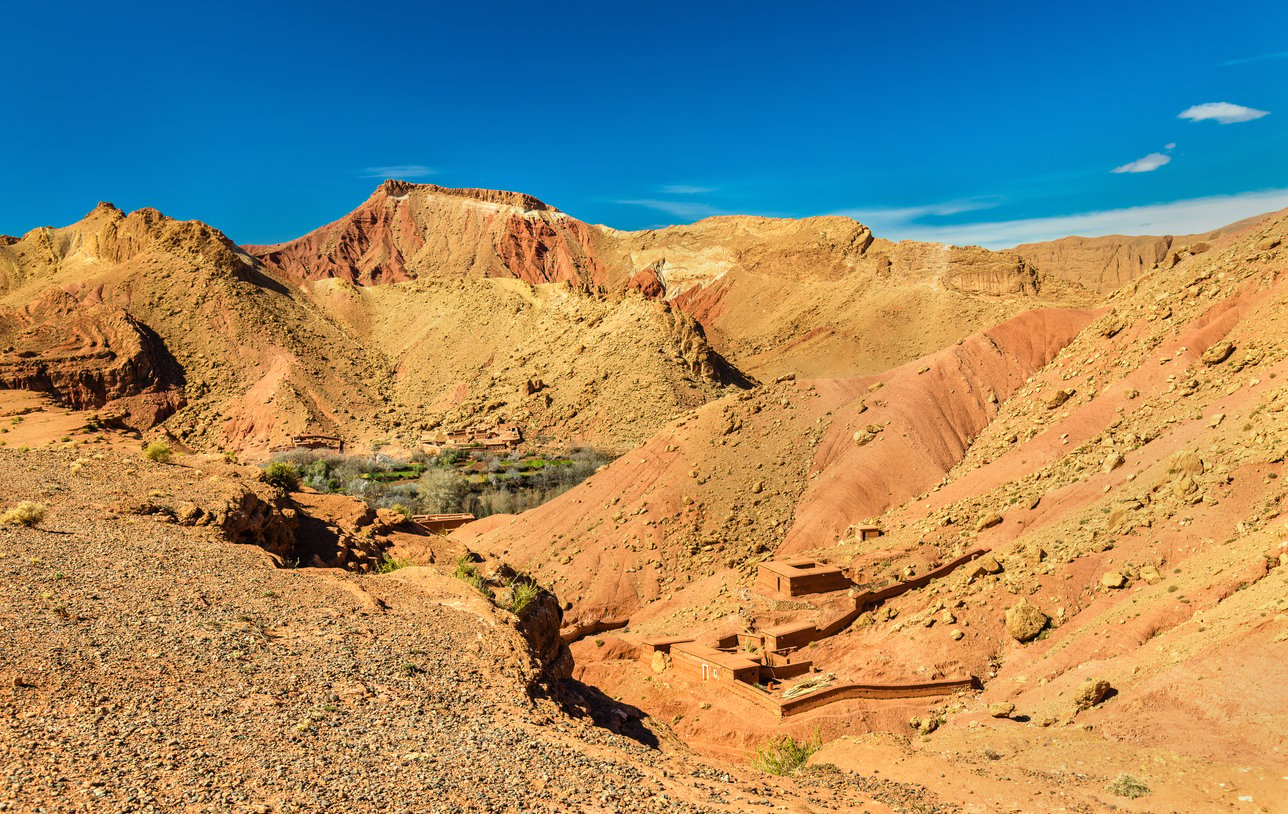
Ouanoukrim, peak number two, is very close to Toubkal – so you could do them both in the same trip. M’Goun is much further east in the High Atlas. It is part of a spectacular long ridgeline all at or above 4000m. You can pick which bit of the ridge you want to do based on your experience and the time available.
2. The Middle Atlas Mountains
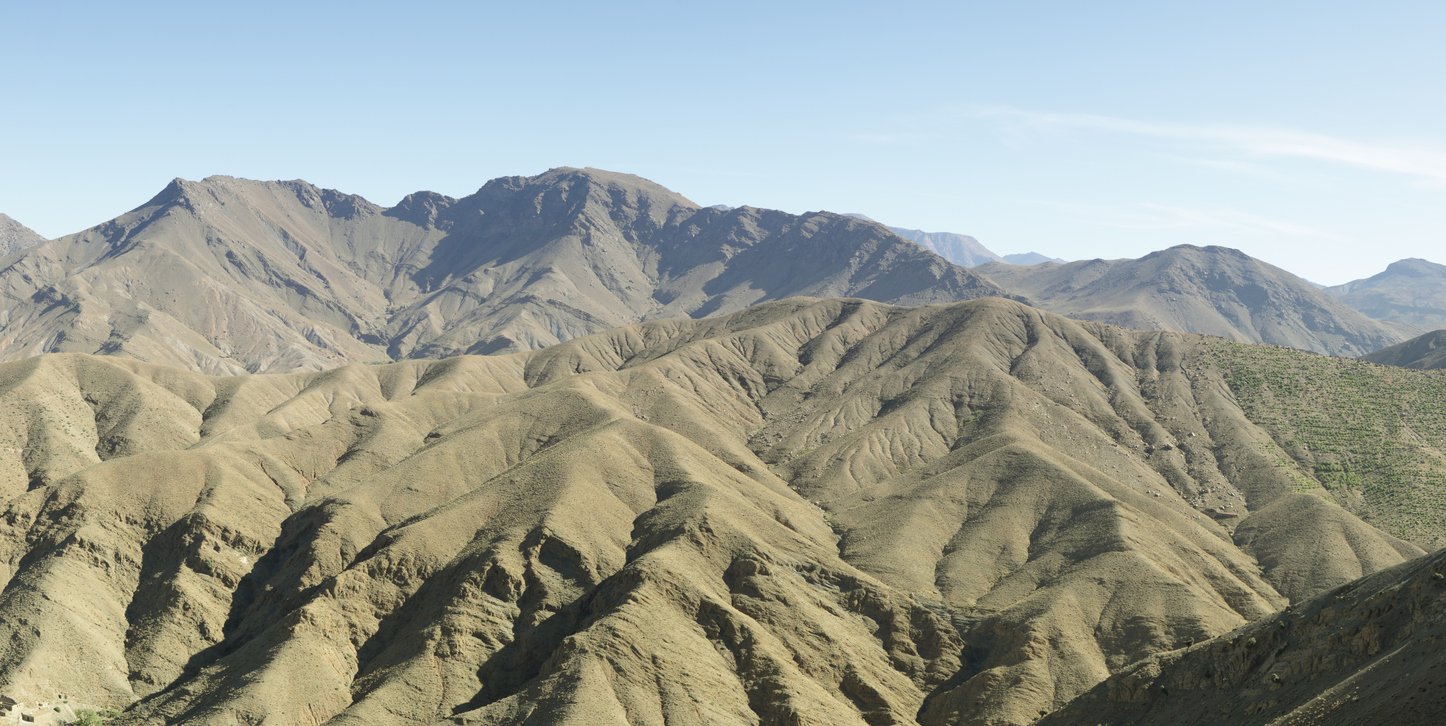
Highest Point: Mount Bou Naceur (3,340m)
Best Time to Visit: March-May, September-November
Best Multi-Day Adventure: Trek the Atlas Mountains
Although the peaks don’t reach the lofty heights of the High Atlas, the Middle Atlas has its own charms. For example, Ifrane National Park is genuinely referred to as “Little Switzerland“. It’s got a ski resort and everything. The mountains are just the right height to make the climate seem alpine… and it’s convincing! Not something you might expect to find in Morocco.
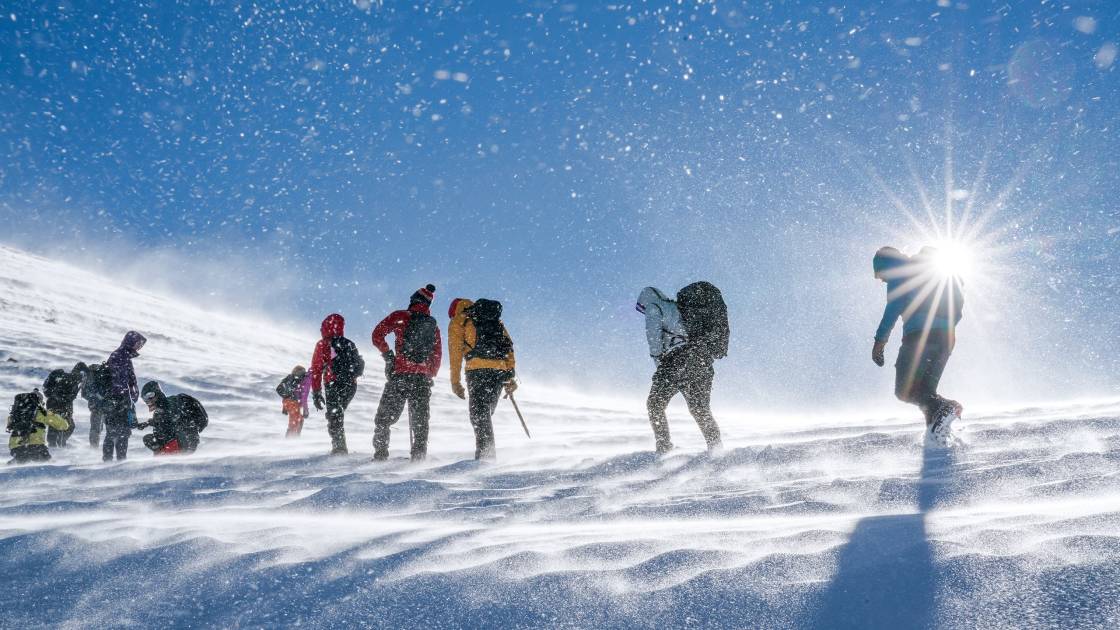
In amongst this alpine terrain is an area known as the Land of the Lakes. It makes for pleasant lower-level trekking, like you might find in the alpine areas of Europe. Lake Ouiouane is a particular highlight. This artificial lake is fed by natural springs and sits at 1600m, with the Atlas Mountains as a backdrop.
3. The Anti Atlas Mountains
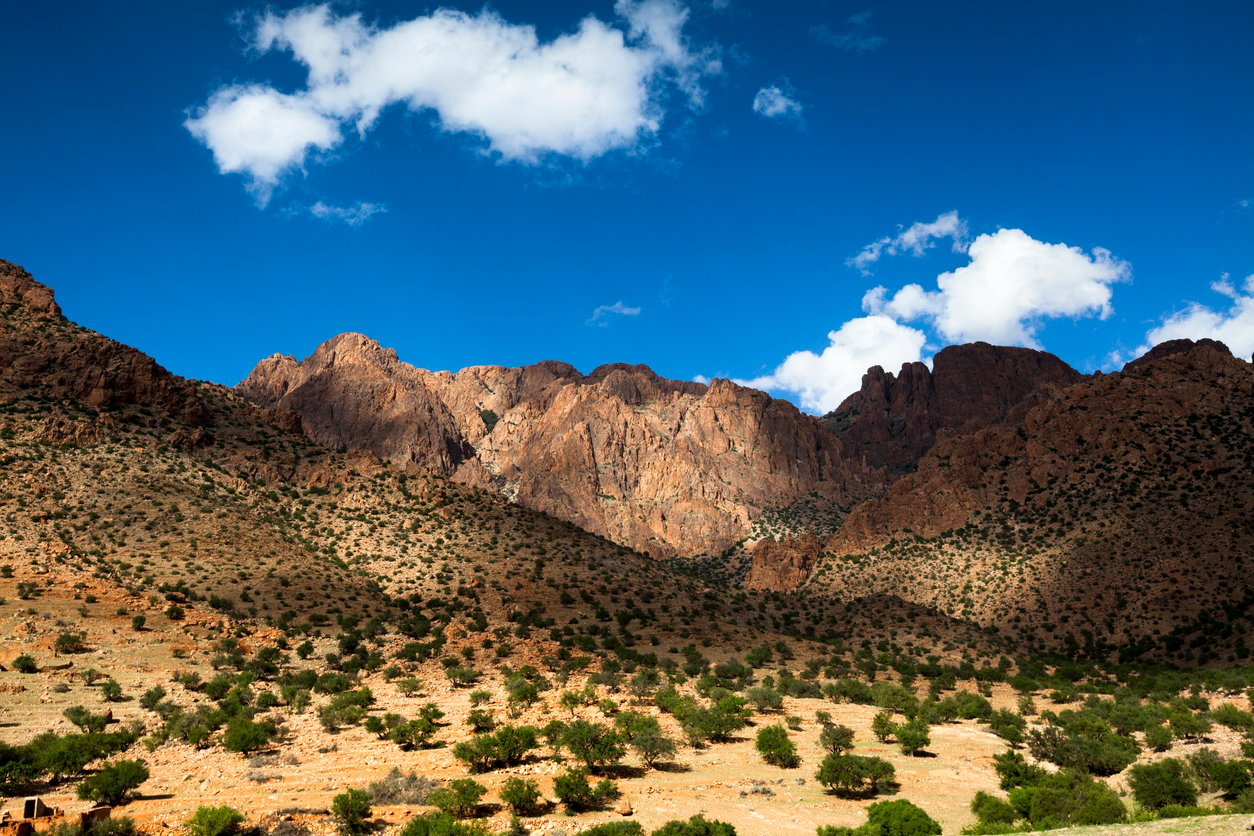
Highest Point: Mount Sirwa (3,304m)
Best Time to Visit: October - May
Best Multi-Day Adventure: Cycle the Backroads of Morocco
Trekking in Morocco’s Anti Atlas is a completely different experience. People liken its arid and unusual terrain to walking on the moon. The Anti Atlas are much lower mountains than their counterparts, reaching 3304m at the highest. Not that that’s anything to be sniffed at! Walks and scrambles in the Moroccan Anti-Atlas mountains are some of the most popular in the country.
Jebel Sirwa is that highest peak: an extinct volcano. The hike is difficult and rocky underfoot, often through boulder fields, but well worth the effort. Another interesting peak is Jebel El Kest, known as the Amethyst Mountain. It has a wonderful long quartzite ridge and a pyramidal summit that can be reached by scrambling.
If peaks aren’t so much your thing, the Ait Mansour Gorge is a welcome break from the barren landscape. The gorge is often impassable in winter because of flooding – allowing a pocket of lush vegetation to grow there in summer months. You can trek the 10km valley through palm groves and and olive trees.
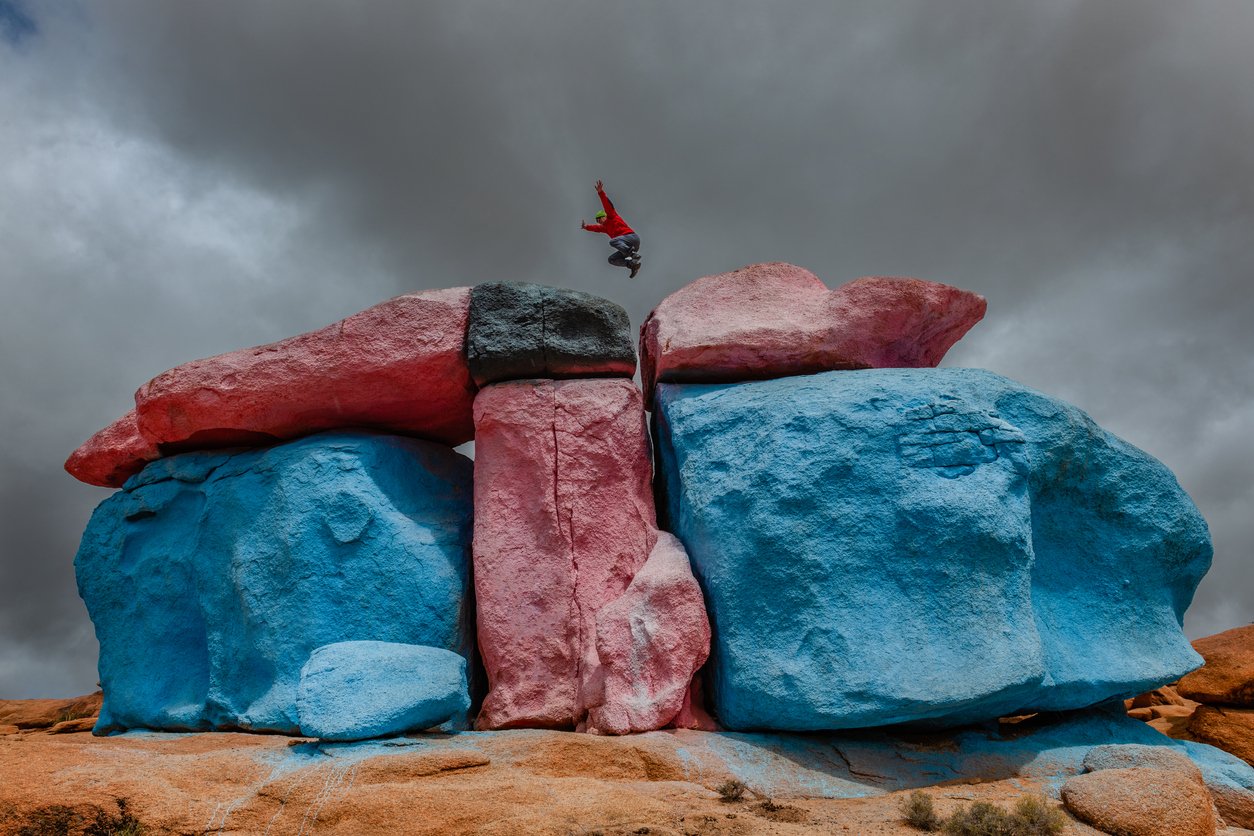
We can’t talk about the Anti Atlas without mentioning the weird painted rocks. The blue painted rocks of Agard-Oudada are getting a bit famous (yes, some of them are pink too). They were first painted by Jean Verame, a Belgian artist, in 1984 as a tribute to his late wife… as you do. Luckily he had the help of a team of firemen to spray the paint through fire hoses.
4. The Rif Mountains
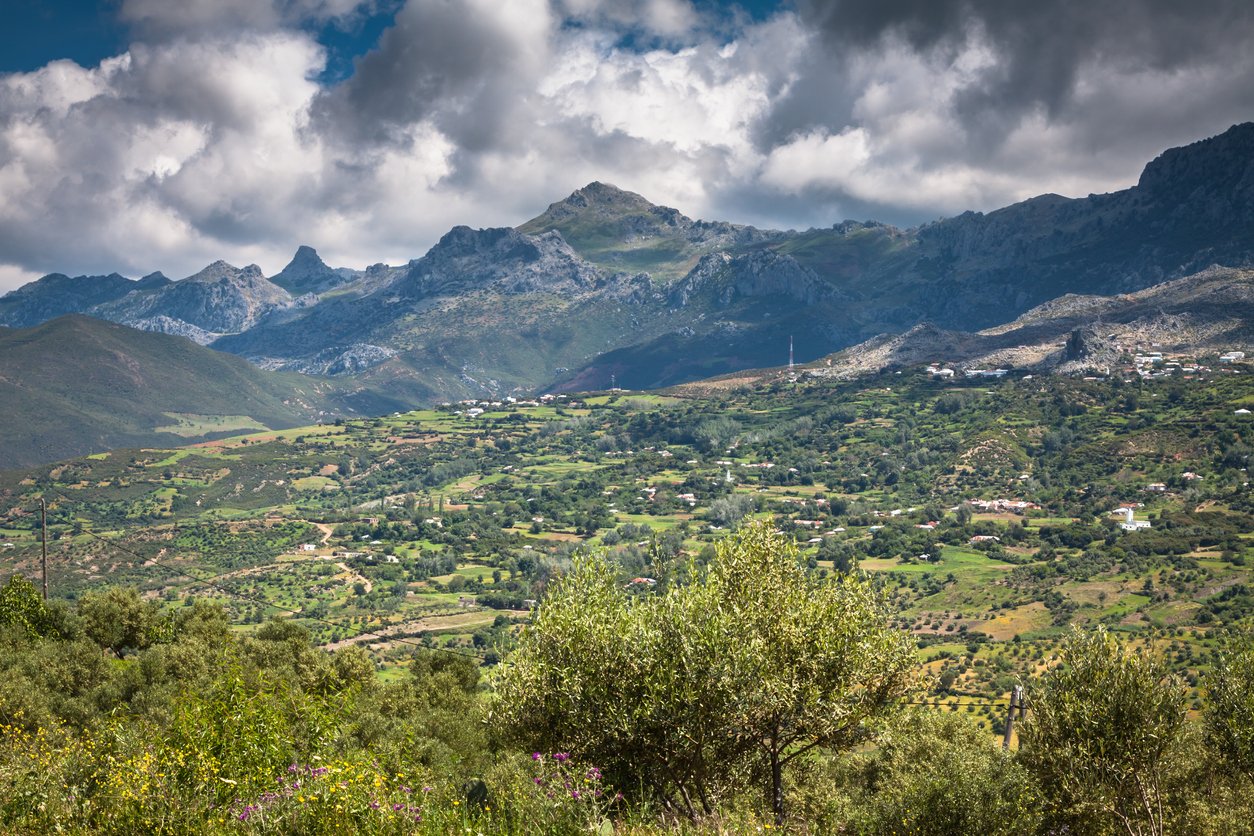
Highest Point: Mount Tidirhine (2,456m)
Best Time to Visit: March - June
Best Multi-Day Adventure: Roam the Ancient Cities of Morocco and Glamp in the Sahara
Despite its beauty, the Rif Mountains are the least well known trekking area in Morocco. The landscape is very different from the other arid mountains further south. Here, there are limestone cliff and gorges, reaching all the way out to the Mediterranean Sea. Mountains on the coast are always exciting. Base yourself in the intriguing 'blue city' of Chefchaouen and you'll be close to some of the best hikes in the region.
The Rif Mountains are also home to Talassemtane National Park. The cedar forests there are criss-crossed with Berber mule tracks, so lots of paths to hike on! If it's a real remote experience you're looking for, trekking the Rif mountains could be for you. Er… and you’re very likely to come across cultivated cannabis whilst you’re there.
And Away from the Mountains, there's the Sahara...
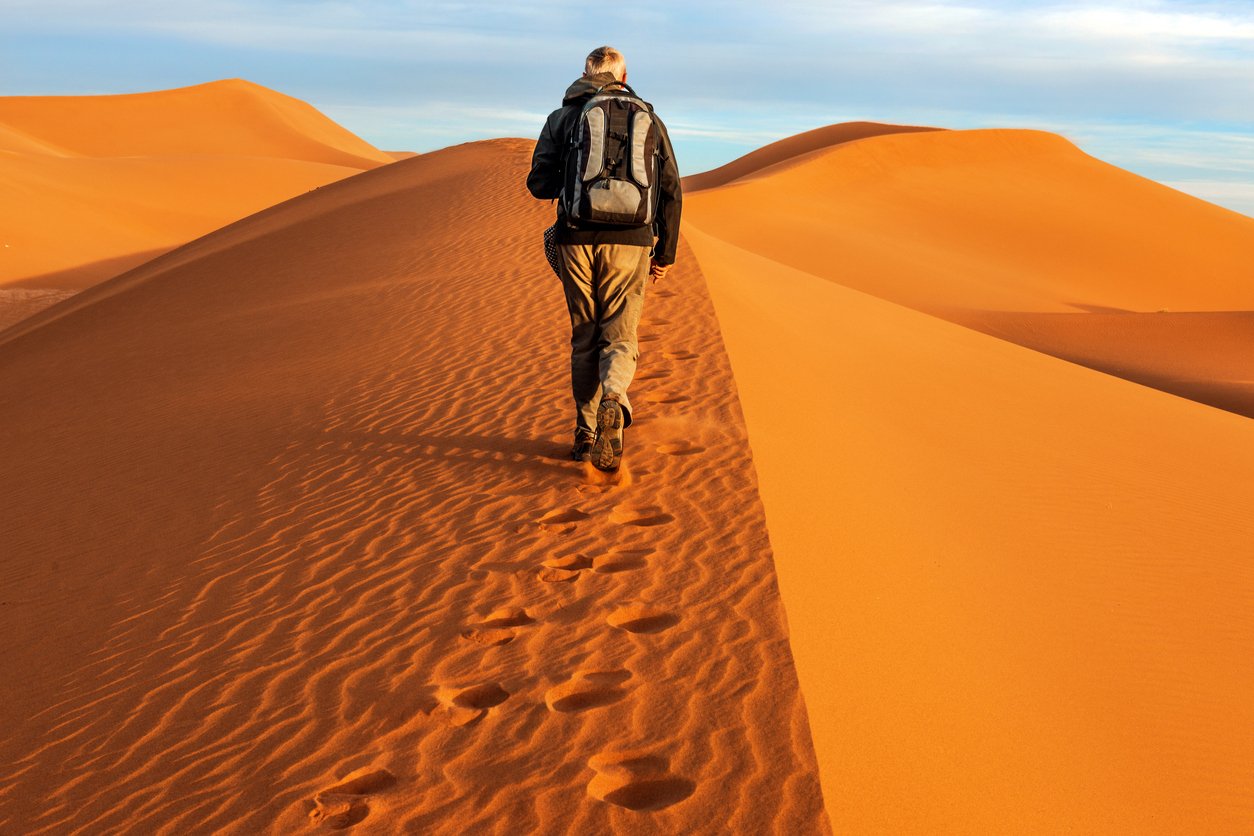
Then, of course, there’s sand. If the idea of trekking across huge dunes with a camel sets off your adventure sensor, then where better than the Sahara desert?
There are lots of opportunities to trek across the Sahara. Many camel treks are available from M’Hamid, the last outpost of modern civilisation before the desert. Here the road ends and the sand begins. You could trek across the Bousnaina Plain to Erg Chigaga or start at Zagora and trek across to M’Hamid.
Enjoyed this article? You might also like:
- Atlas Mountains: Your Adventure Guide
- The Guide to Climbing Mount Toubkal
- 5 of the Best Hikes in the Rif Mountains
Inspired? Check out our full range of Morocco tours!



